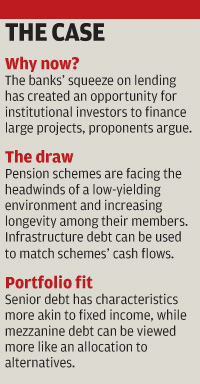A consequence of the restructuring of banks’ loan books is that UK pension funds are going to be spoilt for choice when it comes to infrastructure debt offerings.
Allianz Global Investors plans to launch a fund focusing on the UK later this year, BlackRock is planning a European infrastructure debt launch, while Aviva Investors will launch a euro-denominated European secondary debt fund by the end of the year.
For the full The Specialist report on property and infrastructure, go here to find the PDF.

And AMP Capital, having invested more than half of the €400m (£337m) infrastructure debt fund it closed in 2012 is planning to raise capital for a $1bn (£646m) fund this year.
But should pension funds take advantage of this opportunity, and if so why have they not already?
“Traditionally, more than 90 per cent of these assets have been funded by banks,” says Duncan Hale, head of infrastructure research at Towers Watson. “So as an institutional asset class it’s new.”
Hale says such an asset is potentially very attractive to schemes. “Pension funds are looking for ways to increase returns,” he says. “And with journey plans that last 15, 20 or 25 years they could afford to take on more illiquidity. So it seems a natural fit.”
The case for debt
So could infrastructure debt replace corporate bonds or low-yielding government debt in pension fund portfolios? Andrew Wiggins, head of institutional business development at Allianz GI, makes the case.
“It’s senior debt, so at the top of the debt structure, and has an investment-grade rating – a minimum BBB- that rises during the life of a project as the construction risk diminishes,” he says. “And there’s a yield advantage, of perhaps 300 basis points over 10-year gilts, partly as an illiquidity premium.
“But this is good for pension funds because they have long-dated liabilities that are difficult to match. Infrastructure debt typically has a 30-year maturity with stable cash flows and great predictability.”
The debt is not a liability match per se but the attraction is cash flow matching, he adds. “And they are like gilts in that ultimately government revenues pay for, for example, the hospital, and those revenues pay the interest on the debt.”
But this sort of greenfield project, where PFI/PPP schemes are constructed from scratch, are not the only infrastructure debt offering.
“We are a brownfield fund,” says Gerry Jennings, principal for infrastructure debt at AMP Capital. “We invest in mature assets – utilities, airports, roads, rail – that are typically bought by infrastructure equity sponsors where, for example, a large corporate wants to divest a non-core business.”
AMP Capital’s 10-year closed-end fund model means a pension fund wanting liability matching has to choose between a 2-3 per cent return for 20 years or an 8-10 per cent for four or five years, where once the debt is repaid they can recycle the capital into the next fund, he adds.
So where does it fit in a portfolio? “Broadly speaking, while the returns from a senior strategy mean it’s more akin to fixed income, the returns we’re generating mean it’s more like an alternative allocation,” Jennings says.
George Coats is a freelance journalist
For the full The Specialist report on property and infrastructure, go here to find the PDF.






















